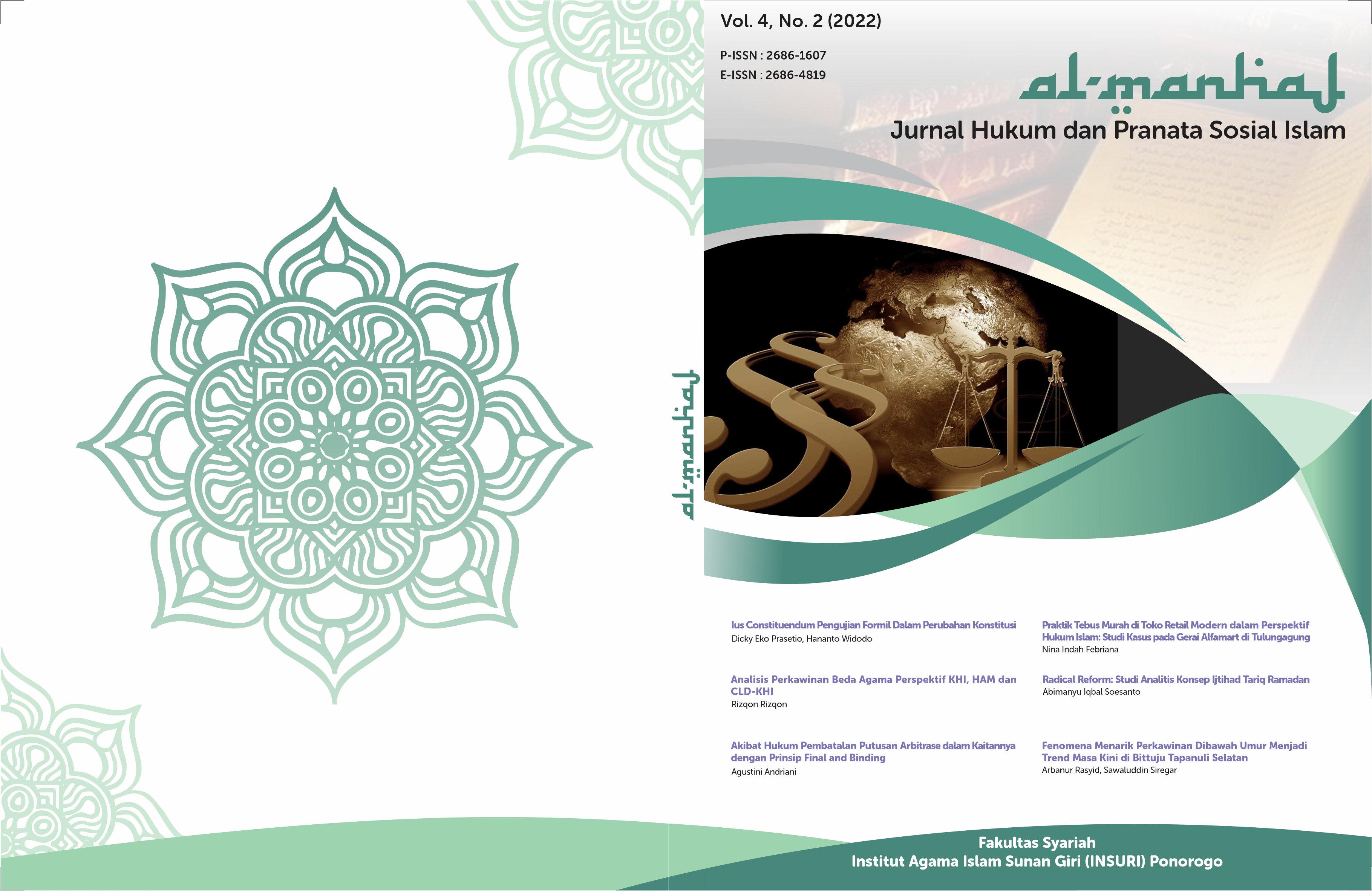Pernikahan Dini Dalam Upaya Menjauhi Zina: Solusi atau Kontroversi?
DOI:
https://doi.org/10.37680/almanhaj.v4i2.1716Keywords:
Marriage; Early-age marriage; Adultery; IslamAbstract
Nowadays, early age-marriage mostly happen in Indonesia because of married by accident, demands of customs, parents, and others. Indonesia is the 2nd country in Asia with the highest rate of early marriage and 37th in the world in 2007 (According to the United Nations Development Economic and Social Affairs (UNDESA) in 2010). In this study, researchers have more interest in exploring the phenomenon of early marriage that is rife by focusing on studying and knowing about early marriage as a solution or controversy to avoid an act of adultery. According to the view of Islam, customary law, and other laws. This study uses descriptive quantitative methods with data collection using a questionnaire. Although Islam does not determine the age for marriage, there are many factors that cause a negative impact if early marriage is not carried out with a good preparation. This thing will affect the psychological, physiological, social, economic, and other factors that lead to disadvantage. Therefore, it is better to prepared marriage more maturely before making a decision, because marriage in Islam is a worship and sacred thing.
References
Amalia, M. (2018). Prostitusi dan Perzinahan dalam Perspektif Hukum Islam. Tahkim (Jurnal Peradaban dan Hukum Islam).
Asrori, A. (2015). BATAS USIA PERKAWINAN MENURUT FUKAHA DAN PENERAPANNYA DALAM UNDANG-UNDANG PERKAWINAN DI DUNIA ISLAM. AL-'ADALAH, 810.
Atabik, A., & Mudhiiah, K. (2014). Pernikahan dan Hikmahnya Perspektif Hukum Islam. Yudisia, 5(2), 293–294.
Bastomi, H. (2016). Pernikahan Dini Dan Dampaknya (Tinjauan Batas Umur Perkawinan Menurut Hukum Islam Dan Hukum Perkawinan Indonesia). Pernikahan Dini Dan Dampaknya, 7(2), 354–384.
Direktorat Pembinaan Peradilan Agama. (2003). Himpunan Peraturan Perundang-Undangan dalam Lingkungan Peradilan Agama. Jakarta: Yayasan al-Hikmah.
Fahmi. (2020). Zina Dalam Presfektif Hukum Islam dan Hukum Positif.
Fushshilat, S. R., & Apsari, N. C. (2020). Sistem Sosial Patriarki Sebagai Akar Dari Kekerasan Seksual Terhadap Perempuan Patriarchal Social System As the Root of Sexual Violence Against Women. Prosiding Penelitian Dan Pengabdian Kepada Masyarakat, 7(1), 121. https://doi.org/10.24198/jppm.v7i1.274. Jurnal Ilmiah Ahwal Syakhshiyyah, 1(1), 50–56. http://riset.unisma.ac.id/index.php/JAS/article/view/2740
Gunawan I. (2019). Kuantitatif Imam Gunawan. 29.
Hamdi, A. S., & Bahruddin, E. (2015). Metode penelitian kuantitatif aplikasi dalam pendidikan. Deepublish.
Hidayat, I. (2017). Analisis Normatif Tindak Pidana Perzinahan Dilihat Dalam Perspektif Hukum Islam. Jurnal Ilmiah Universitas Batanghari Jambi, 44-48.
Hadiono, A. F. (2018). Pernikahan Dini dalam Perspektif Psikologi Komunikasi. Jurnal Darussalam: Jurnal Pendidikan, Komunikasi dan Pemikiran Hukum Islam, 9(2), 385-397.
Iqbal, M. (2020). Psikologi Pernikahan: Menyelami Rahasia Pernikahan. Gema Insani.
Jawas, Y. b. (2011). Panduan Keluarga Sakinah. Jakarta: Pustaka Imam Asy-Syafi’.
Kenedi, J. (2019). Analisis Pemidanaan Terhadap Perzinahan dalam Perspektif Hukum Positif dan Hukum Islam. Nuansa: Jurnal Studi Islam dan Kemasyarakatan.
Ligit, Meiliati. 2016. “Kontrol Diri Dan Penyesuaian Diri Dalam Pernikahan Remaja Putri Yang Menjalani Pernikahan Dini Akibat Kehamilan Pra Nikah.” Psikoborneo: Jurnal Ilmiah Psikologi 4(3):422–31.
Mahkamah Agung RI. (2015). Kompilasi Hukum Islam (KHI). Jakarta: Direktorat Jenderal Badan Peradilan Agama.
Mahkamah Agung RI. (n.d.). Kompilasi Hukum Islam (KHI).
Manshur, A. (2017). Hukum dan Etika Pernikahan dalam Islam. Universitas Brawijaya Press.
Mendidik Anak dalam Kandungan. (2014). Jakarta: Gema Insani.
Mufidati, K. (2020). Fenomena Pernikahan Dini Akibat Hamil Pranikah. Ahkam: Jurnal Hukum Islam, 8(1), 45–62. https://doi.org/10.21274/ahkam.2020.8.1.45-62
Muhyi, J. a. (2006). Jangan Sembarang Menikah Dini. Depok: PT. Lingkar Pena Kreativa.
Mustika, I. T. (2017). PUTUSAN DISPENSASI BATAS USIA PERNIKAHAN PERSPEKTIF MADZHAB SYAFI’I DAN HANBALI (Studi di Pengadilan Agama Tangerang dan Situbondo Tahun 2015). 1–178.
Nurselin, D. S., Zabar, M. A., Nurdianti, R., & Suyandi, D. (2021). Analisis Faktor Penyebab dan Dampak Pernikahan Dini di Desa Pakuon Kecamatan Sukaresmi Kabupaten Cianjur. PROCEEDINGS UIN SUNAN GUNUNG DJATI BANDUNG, 1(32), 132-145.
Rahmawati, S. (2020). Batas Usia Minimal Pernikahan (Studi Komparatif Hukum Islam dan Hukum Positif. Syakhsia: Jurnal Hukum Perdata Islam, 85-110.
Romli, Usup, Jenuri, Dina Mayadiana Suwarma, Mohammad Rindu Fajar Islamy, and Muhamad Parhan. 2021. “PENGEMBANGAN MEDIA PEMBELAJARAN AKIDAH DENGAN KONSEP ‘QURANI’ BERBASIS ICT UNTUK SISWA SEKOLAH.” Jurnal Pendidikan Dan Pengajaran Guru Sekolah Dasar (JPPGuseda) 4(1):60–64.
Rusdi, M. A. (2016). Status hukum pernikahan kontroversial di indonesia (telaah terhadap nikah siri, usia dini dan mutah). Al-Adl, 9(1), 37–56. https://ejournal.iainkendari.ac.id/index.php/al-adl/article/view/667
Salam, L. (2007) Menuju Keluarga Sakinah. Surabaya: Terbit Terang.ST.
Sahri, A., & Arif, S. (2018). Kedudukan Hukum Nikah Siri Menurut Madzhab Syafiâ€TMi dan Maliki. Mizan: Journal of Islamic Law, 1(1), 93–122. https://doi.org/10.32507/mizan.v1i1.119
Setiawan, H. (2020). Pernikahan Usia Dini Menurut Pandangan Hukum Islam. Borneo: Journal Of Islamic Studies, 59-74.
Shufiyah, F. (2018). Pernikahan Dini Menurut Hadis dan Dampaknya. Jurnal Living Hadis, 3(1), 47. https://doi.org/10.14421/livinghadis.2017.1362
Soendari, T. (2012). Metode Penelitian pendidikan Deskriptif oleh Tjutju Soendari. Metode Penelitian Deskriptif, 2(2), 15–23.
Umah, H. N. (2020). Fenomena Pernikahan Dini di Indonesia Perspektif Hukum-Keluarga-Islam. Jurnal Al Wasith: Jurnal Studi Hukum Islam,.
Wahyuni, A. (2020). Pernikahan Dini Menurut Perspektif Madzhab Imam Syafi’I. Imtiyaz: Jurnal Ilmu Keislaman, 4(1), 62-85.
Widarti, S. (2017). Analisis wacana pesan dakwah dalam acara Talkshow cerita perempuan tema kontroversi pernikahan dini di Trans TV tanggal 17 agustus 2016 (Doctoral dissertation, IAIN Ponorogo).
Yusuf, A. M. (2016). Metode Penelitian Kuantitatif, Kualitatif & Penelitian Gabungan. Prenada Media.
Zamroni, Z. (2021). Pernikahan Dini Dalam Perspektif Hukum Positif, Hukum Adat Dan Fiqh. MISYKAT Jurnal Ilmu-ilmu Al-Quran Hadist Syari ah dan Tarbiyah, 117-136.Abdullah, P. M. (2015). Living in the world that is fit for habitation : CCI’s ecumenical and religious relationships. In Aswaja Pressindo.
Downloads
Published
How to Cite
Issue
Section
License
Copyright:
- Author retains the copyright and grants the journal the right of first publication of the work simultaneously licensed under a Creative Commons Attribution 4.0 International License that allows others to share the work with an acknowledgment of the work's authorship and initial publication in this journal.
- Author is able to enter into separate, additional contractual arrangements for the non-exclusive distribution of the journal's published version of the work (e.g., post it to an institutional repository or publish it in a book) with the acknowledgment of its initial publication in this journal.
- Author is permitted and encouraged to post his/her work online (e.g., in institutional repositories or on their website) prior to and during the submission process, as it can lead to productive exchanges, as well as earlier and greater citation of the published work (See The Effect of Open Access).
License:
-
Attribution — You must give appropriate credit, provide a link to the license, and indicate if changes were made. You may do so in any reasonable manner, but not in any way that suggests the licensor endorses you or your use.
-
No additional restrictions — You may not apply legal terms or technological measures that legally restrict others from doing anything the license permits.
You are free to:
- Share — copy and redistribute the material in any medium or format
- Adapt — remix, transform, and build upon the material for any purpose, even commercially.

This work is licensed under a Creative Commons Attribution 4.0 International License.














